
Driving on a flat tire is a common and hazardous situation that many drivers face. When a tire loses air pressure, it compromises the vehicle's handling, braking, and overall safety. Understanding the risks associated with driving on a flat tire and knowing the appropriate steps to take can prevent further damage to your vehicle and ensure your safety on the road. This article explores the consequences of driving on a flat tire, the potential damages, and the best practices for handling a flat tire safely.
Understanding the Risks of Driving on a Flat Tire
Driving on a flat tire is not only inconvenient but also hazardous. When a tire loses air pressure, it can no longer support the weight of your vehicle properly. This imbalance can lead to a host of issues, from damaging your wheel to compromising your vehicle's handling and braking capabilities. Imagine trying to steer your car with a flat tire—it's akin to walking on a sprained ankle. You might manage for a short distance, but it's going to hurt and could lead to a bigger problem.
Damage to the Wheel and Tire
One of the immediate risks of driving on a flat tire is the potential damage to the wheel itself. The flat tire creates a direct contact between the wheel rim and the road surface, which can result in significant damage to the wheel. Repairing or replacing a wheel is far more expensive than fixing a flat tire. Furthermore, the tire itself can be ruined beyond repair if driven on while flat. Even if the tire was initially repairable, prolonged driving on it can make it unsalvageable.
Impact on Vehicle Control and Safety
A flat tire drastically affects your car's handling and safety. With one tire not providing the necessary traction, your vehicle can pull to one side, making it difficult to steer straight. This compromised control can be especially dangerous at high speeds or in heavy traffic. Braking performance is significantly reduced, increasing the risk of an accident. A sudden stop could cause your car to skid, potentially leading to a collision. Safety should always be your priority, and driving on a flat tire undermines it severely.
Potential for Further Mechanical Damage
Beyond the tire and wheel, driving on a flat can cause damage to other parts of your vehicle. The suspension system, axle, and even the alignment can be affected by the uneven load distribution. Over time, this can lead to more extensive and costly repairs. The vibrations and instability caused by a flat tire can also interfere with the electronic systems in modern cars, potentially leading to sensor malfunctions or warning light issues. In short, continuing to drive on a flat tire can turn a minor inconvenience into a major repair bill.
What to Do When You Have a Flat Tire
If you experience a flat tire, the best course of action is to pull over safely and address the issue immediately. Here are the steps you should follow:
Find a Safe Spot to Pull Over
Look for a safe area away from traffic, such as the shoulder of the road or a nearby parking lot. Turn on your hazard lights to alert other drivers.
Assess the Situation
Once you've stopped, inspect the tire to determine the cause of the flat. If you're not comfortable changing the tire yourself or if you don't have the necessary tools, it's best to call for roadside assistance.
Change the Tire or Call for Help
If you have a spare tire and the tools to change it, you can do so by following your vehicle's manual. Ensure the car is on a flat surface and use the jack properly to avoid accidents. If changing the tire isn't an option, call for roadside assistance or a tow truck.
Drive to the Nearest Repair Shop
After installing the spare tire, drive slowly and carefully to the nearest repair shop to have the flat tire repaired or replaced. Remember, spare tires are not designed for long-distance travel or high speeds, so it's crucial to get the flat fixed as soon as possible.
Preventing Flat Tires
While some flat tires are unavoidable, regular maintenance can minimize the risk. Check your tire pressure monthly and ensure it matches the manufacturer's recommendations. Inspect your tires for signs of wear and tear, such as cracks, bulges, or embedded objects. Rotate your tires regularly to promote even wear and extend their lifespan. By keeping your tires in good condition, you can reduce the likelihood of unexpected flats and improve your overall driving safety.
Keep your vehicle in top condition with regular maintenance. Schedule an inspection at Four Car Garage today and drive with confidence.